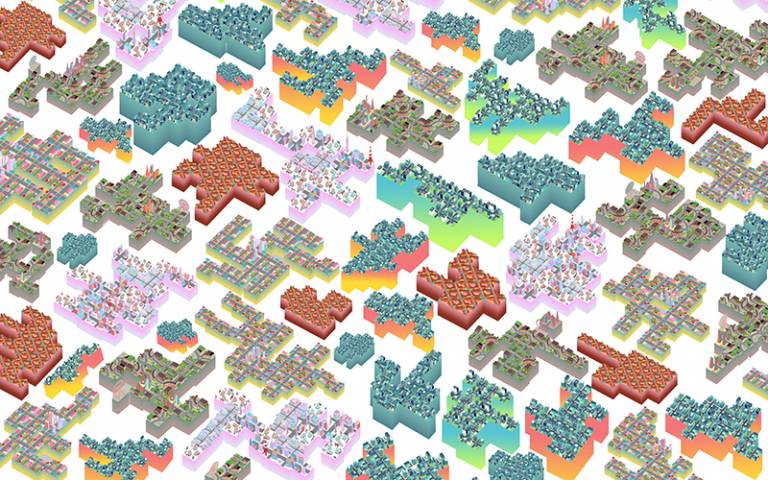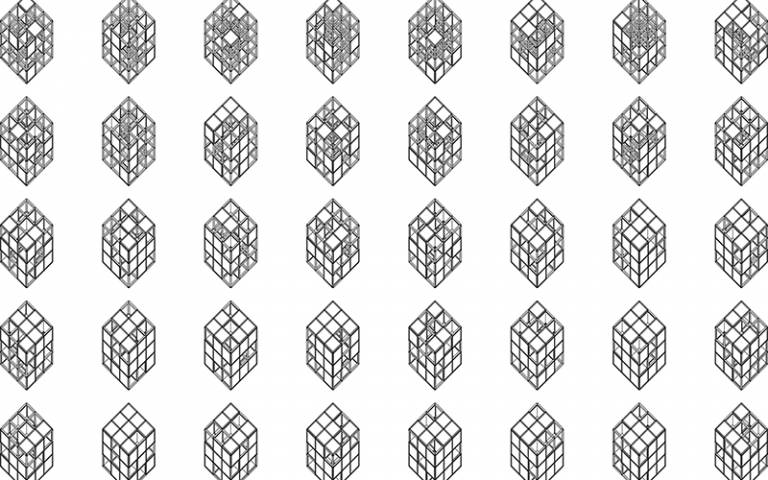B-Pro Prospectives Lecture Series Spring 2021
17 February 2021–12 May 2021, 1:00 pm–2:00 pm

A B-Pro History and Theory lecture series, highly recommended for Architectural Design, Urban Design and Architectural Computation students as well as interested professionals.
This event is free.
Event Information
Open to
- All
Availability
- Yes
Cost
- Free
Organiser
-
Roberto Bottazzi
About
The B-Pro Prospectives History and Theory Lecture Series offers a platform for presentation, discussion and theoretical reflection upon the links between digital thought, architecture, and urban design. This year's series of talks emphasise the key role computation plays within complex design synthesis and their cultural implications.
This series encourages and inspires the current student body and interested professionals, by creating conversations about topics addressing academia, practice and beyond as well as overall disciplinary concerns and frontiers.
B-Pro, or Bartlett Prospective, groups together five of the school's graduate programmes with a unique philosophy and shared approach to the future of design, architecture and the urban environment. The B-Pro Prospectives lecture series is organised by Roberto Bottazzi and Emmanouil Zaroukas.
For this term's series, all events will be held in Zoom. Check the schedule for individual registration links to each event.
More scheduled events to be announced shortly.
Schedule
- 04 February | 13:00 | Vera Bühlmann
Stars, Meteors, Atomic Time, and the Question of "Novelty" in Architecture
Computation is currently understood mainly in relation to the control of processes, or a latent capacity (to either form or material) for engendering novelty. This lecture will attend to the current interests in 'novelty’ in architecture through the optics of a silent promise for a kind of 'epiphania' (Greek term for a shining forth, a sudden stepping into appearance, and in distinction to what is usually called 'phenomenon'). Novelty is such an interesting theme today because it harbours the possibility for the making of an appearance that were stripped of all subjectivism and anthropocentrism. It is this aspect of novelty and computation which makes it interesting to turn to a largely forgotten link between time and number: 'computus' was the Medieval Latin term for calendar-making (Arno Borst, 1990). How do we 'order’ time today, and how can we think about the relation between architecture and time – via computation – in terms of what I want to call 'Atomic Time'?
Biography
Vera Bühlmann is Professor for Architecture Theory and director of the research group Architecture Theory and Philosophy of Technics ATTP at the Vienna University of Technology. She is the author of Mathematics and Information in the Philosophy of Michel Serres (2020), and co-editor of the Applied Virtuality book series (with Ludger Hovestadt, Birkhäuser, since 2012). Her recent publications include Photosynthesis in Philosophy Today (2020), The Instrumentation of Space: Computational Architecture, Architectonic Models (forthcoming in Ingrid Mayrhofer-Hufnagl (ed.), [UN]TIMELY ARCHITECTURE (transcript, 2021), Atomic Time and Quantum Literacy: Michel Serres' Apologie for Science in Minnesota Review (forthcoming, 2021).
- 10 February | 10:00 | Tessa Leach
Machine Sensation
All objects experience their worlds according to their sensory capabilities. Just as humans sense and communicate in human ways, nonhumans sense and communicate in ways that are alien and inaccessible to us. Technological artefacts are no different – even the ones we design to replace our most uniquely human behaviours. The challenges presented by nonhuman interaction and the pitfalls of anthropomorphism and alienation can influence their social, cultural and technological impact. What are our biases when we consider how technological objects sense and act in our world, and what are the implications? With reference to contemporary metaphysics, Tessa will emphasise the alien qualities of robots and AI to increase (rather than decrease) the tension between nonhuman and human sensation and experience.
Biography
Tessa Leach is the author of Machine Sensation: Anthropomorphism and ‘Natural’ Interaction with Nonhumans (Open Humanities Press, 2020). Her research into anthropomorphic technologies is informed by contemporary theory and metaphysics, including actor-network theory and object-oriented ontology. She completed her PhD in History and Philosophy of Technology at the University of Melbourne in 2018 and is now a digital transformation practitioner at consulting firm Accenture with an interest in technology for good.
- 17 February | 13:00 | Kas Oosterhuis
Another Normal
Reading The Other Now by Yanis Varoufakis we realise that we have lived in Another Now for decades since we embarked on the fusion of art and architecture on a digital platform. Our Other Now is populated with swarms, point clouds, components, assemblies, bodies, scripts and interactions. In our Now there are no traditional doors, windows, no columns, beams, no scaffolding, no molds. No waste on the building site, constituent components are parametrically designed and robotically [CNC] produced. We have left the mass production of components of the same well behind us, we produce series of unique components, and assemble them to building bodies. It is no longer repetition that wins the beauty contest but diversity, variety, complexity, efficiency; maximum complexity based on a minimum number of simple strong rules. Our motto has been since decades: One Building One Detail, or, in other words: Mies Is Too Much. That has become our Other Normal, which seems to be much in sync with the New Normal that will emerge out of the current pandemic. In the Another Normal everything and everyone is digitally and thus scalable connected and distanced as in complex adaptive systems, as in the dynamic swarm.
Biography
Kas Oosterhuis is an innovator, a writer, an educator and a practicing designer, leading the innovation studio ONL [Oosterhuis_Lénárd] which he runs together with his partner in life and business, visual artist Ilona Lénárd. Oosterhuis has been professor from practice of Digital Architecture (Hyperbody) at the TU Delft from 2000 to 2016, and professor at Qatar University from 2017 to 2019.
From the beginning, the leading theme for the design studio ONL, established in 1989, has been the fusion of art and architecture on a digital platform.
Bespoke realized projects include the Salt Water Pavilion, the Web of North-Holland, the A2 Cockpit showroom in Utrecht, the Bálna mixed use cultural center in Budapest and the LIWA tower in Abu Dhabi.
In his book “Towards a New Kind of Building, a Designers Guide to Nonstandard Architecture” (2011) Oosterhuis reveals the fundamentals of his personal design universe, embracing the paradigm shifts from standard to nonstandard architecture and from static to dynamic environments. Kas Oosterhuis is currently writing a new book titled “Interacting Components, A Personal Odyssey”.
- 24 February | 13:00 | Kostas Terzidis
Design Designs Design

A computational design system is presented based on permutations and deep learning. The methodology is based on the idea of extracting something out of everything as opposed to creating something out of nothing: design elements are combined to form all possible design solutions and a neural network helps to extract the best. The system is projected to have many design applications as well as paradoxical cultural implications.
Biography
Kostas Terzidis is a professor at the College of Design and Innovation at Tongji University in Shanghai, China and director of the ShangXiang Lab. Previously, he was an associate professor at Harvard University's Graduate School of Design and assistant professor at the UCLA. He holds a PhD from the University of Michigan, a Masters from OSU, and a diploma from the Aristotle University, Greece. His research is on automated design and permutations. He is author of numerous academic papers and the sole author of four books: 'Permutation Design' (Routledge: 2014), 'Algorithms for Visual Design' (Wiley: 2009), 'Algorithmic Architecture' (Architectural Press: 2006), and 'Expressive Form' (Spon:2003). Between 2011 and 2017 he created and ran a hi-tech startup called Organic Parking, Inc.
- 12 May | 13:00 | Bradley Cantrell
Adaptive Epistemology: failure, nascent vocabularies, and new wilds
The talk will outline a view of the built environment that is critical to develop for designers in the coming century. The problems we face are larger than ever before, are embedded with infinite complexity, and are outside of our cultural understanding. Landscape Architecture and the landscape itself can provide a sinuous connection between our lives, the architecture we inhabit, the urbanism that expresses our desire, and the environments that sustain our very existence. The interface between the built environment and evolving biological and geological systems requires a blurring of previous strategies to address nascent forms of simulation, sensing, logistics, biological engineering, and technological interface to question the dichotomy of the constructed and the natural.
Most importantly, this landscape, the terra, the aqueous bodies and the atmospheric envelopes must be reimagined, both regarding how we see and relate to it but also in how we propose our future. We have positioned the discipline of landscape architecture as a body of knowledge that can design across scales and produce controlled scenarios from the molecule to the territory, but we are still proposing a future based on the praxis that was defined by modernism, a quest for truths and subsequent propositions that are couched in certainty.Biography
Bradley Cantrell is Chair and Professor of Landscape Architecture at the University of Virginia. His work focuses on the role of computation and media in environmental and ecological design. He has held academic appointments at the Harvard Graduate School of Design, The Rhode Island School of Design and the Louisiana State University Robert Reich School of Landscape Architecture. His work in Louisiana over the past decade points to a series of methodologies that develop modes of modeling, simulation, and embedded computation that express and engage the complexity of overlapping physical, cultural, and economic systems.
Image: ‘Procedural Liveability’ by Aafreen Rahiman, RC12, Urban Design MArch, 2020
 Close
Close

